THE GRANADA THEATRE CIRCUIT
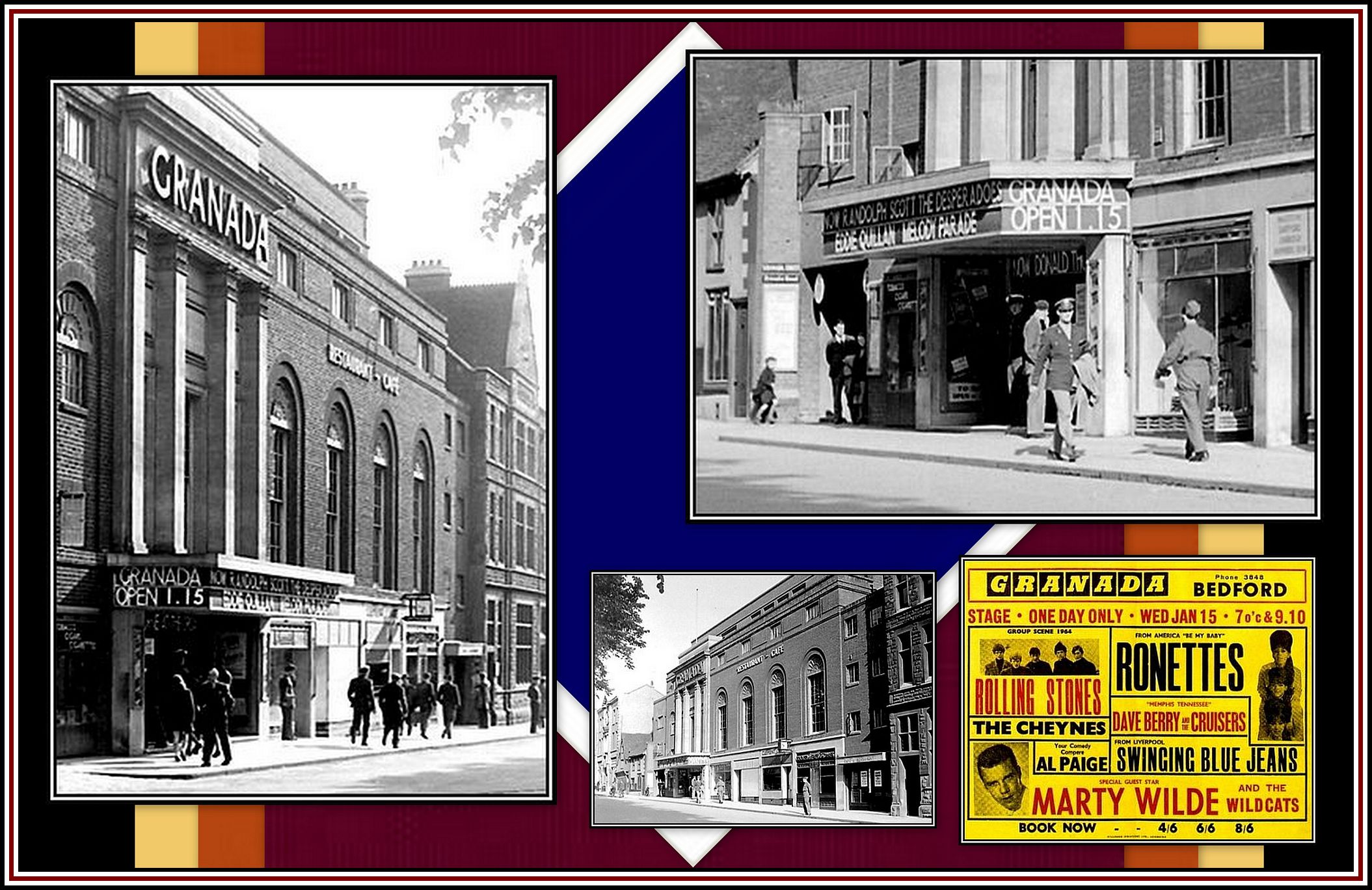 The Granada Theatre Bedford during the days of the Second World War
The Granada Theatre Bedford during the days of the Second World War
Top Right: Both American and British Servicemen are seen walking past the theatre, and if you look carefully, a Granada Sergeant is on duty and standing at the entrance.
Bottom Right: poster from a 1960s Stage Show
—ooOoo—
PART TEN: STARTING A CIRCUIT
—ooOoo—
THE BEGINNING
-oOo-
Sidney and Cecil Bernstein were born into the entertainment business. Their mother and father, Jane and Alexander Bernstein, were involved in the building of the Empire Theatre Edmonton in 1906, and by the time their father died in 1922, the business had grown to include a number of Empire Kinemas in London together with divisions involved in the selling of cinema equipment and the booking and distribution of films. With the passing of their father, Sidney Bernstein took over the family business, and together with his brother, Cecil, they would turn it into, in my opinion, the most glorious of Theatre Circuit in Britain.
-oOo-
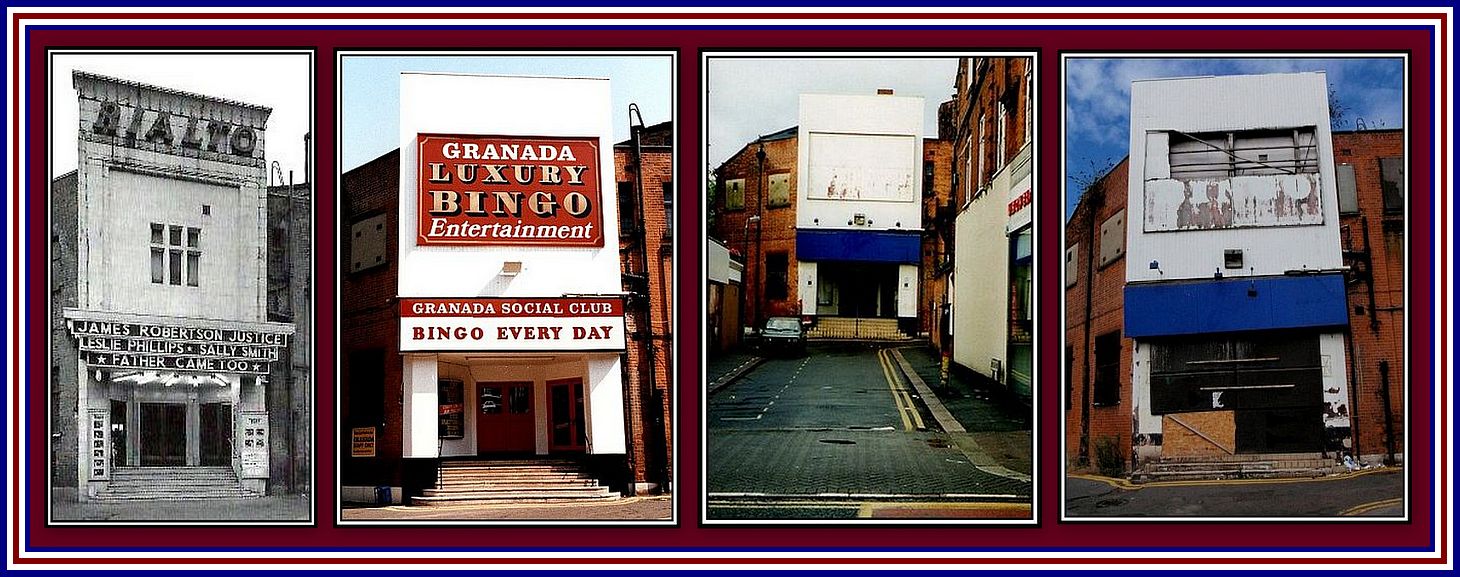 The Exterior of the Rialto Theatre Enfield Over the Years
The Exterior of the Rialto Theatre Enfield Over the Years
The Rialto Theatre Enfield was leased to Sidney Bernstein in 1925, but was not acquired fully by Granada Theatres until 1965. It was renamed Granada in 1967, but closed as a cinema in 1971, but reopened as a Granada Social Club. In 1991, it became a Gala Bingo Club in 1991 and remained open until 1997 when it closed for the last time. The building sat empty and in disuse until 2010 when it was finally demolished.
-oOo-
The brothers began building their circuit from modest and somewhat humble beginnings. Between 1927 and 1930, the number of cinemas operated by Bernstein Cinemas had grown to ten in all. However, this number was not enough for them! The Bernsteins had their eye on something bigger.
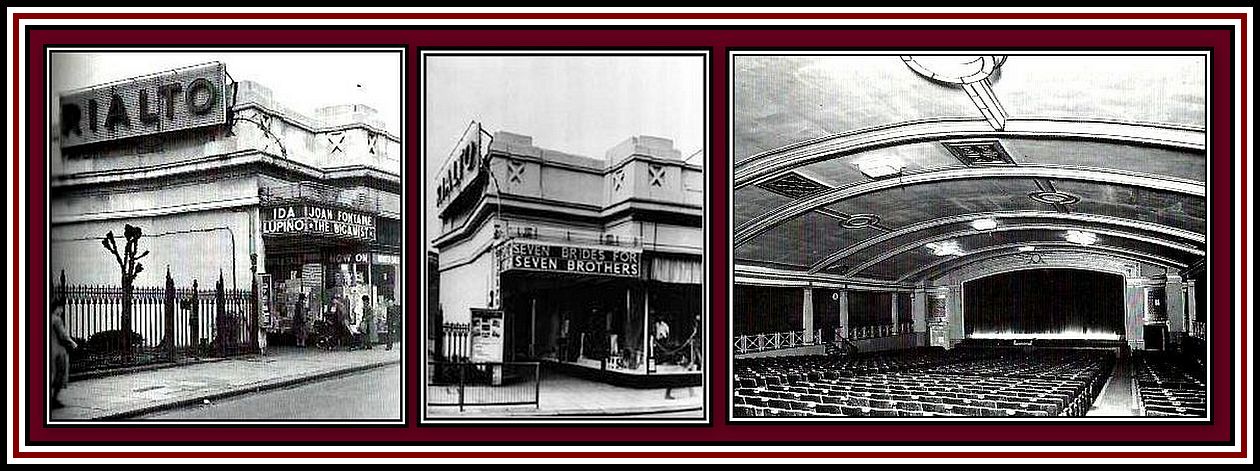 The Rialto Theatre Leytonstone
The Rialto Theatre Leytonstone
The Rialto Theatre Leytonstone was acquired by Sidney Bernstein in 1926 and underwent major changes. In 1928, Denham-Gaumont took it over with Mr. Bernstein still managing it. The building was damaged during the Second World War and was closed for ten months. It was fully acquired by Granada Theatres Ltd. in 1965 and renamed Granada in 1967. The Compton Organ was removed in 1973 and housed at St. Mary’s Church in Hornchurch. Later the organ was purchased by Byron Jones, the organist, and restored by him and his friends and is housed currently in the Methodist Church Hall at Eden Grove, Horfield near Bristol and played monthly for both concerts and dances. The theatre closed in 1974 and was demolished soon after.
—ooOoo—
THE TIMES THEY ARE A-CHANGING!
-oOo-
During the 1920s and 1930s, the public was looking more and more to the cinema, as opposed to the Music Hall, for their major form of entertainment. It was an exciting time: silent films were giving way to sound and film was opening up the world for the price of a ticket. Cinemas were being built throughout the country and many erstwhile Music Halls were being converted to either full-time cinemas or else were offering a combination of film and live entertainment to attract the public.
—ooOoo—
THE COMPETITION
-oOo-
Although there were many British Cinema Circuits during those early years, there were three that would emerge as leaders in the film exhibition industry: the ABC, Gaumont and Odeon Circuits. These three circuits offered formidable competition and any fledgling circuit wishing to spread its wings in the hope of becoming a force to be reckon with in the area of film exhibition had their work cut out for them.
-oOo-
John Maxwell established the Associated British Cinema (ABC) Circuit in 1927 by merging three smaller Scottish cinema circuits. In the 1930s, by a building programme with W.R. Glen as chief architect and by take overs, the ABC Circuit became a major force in the film exhibition industry. The Circuit operated 137 cinemas by 1933 and went on to operate a maximum of 404 cinemas by 1950. ABC cinemas had a characteristic look that was unique amongst cinemas.
-oOo-
The Gaumont British Picture Corporation was the British division of the French film company, Gaumont and became independent in 1933 when it was acquired by Isidore Ostrer. It was at this time the largest Circuit in Britain, operating some 287 cinemas. Although many of these cinemas were indeed glorious, to my untrained eye, they were no where as startling as those of the Odeon Circuit.
-oOo-
Oscar Deutsch opened his first cinema in 1928 and by 1933 was operating 26 Odeon Cinemas. The number grew by 1937 to 250 including the Circuit’s Flagship Cinema, the Odeon Leicester Square, London. The Odeon Circuit was considered to be the most comfortable and also the most respectable for middle class patrons. I can certainly atest to the comfortable and classy atmosphere of an Odeon Cinema. The colours of an Odeon were chocolate brown and gold and all staff members were dressed in an elegant uniform in these colours. The cinemas were tastefully decorated and one felt that one was somewhere very special when one went to an Odeon! It needs to be remembered that during my early years, I was deprived, as alas there was no Granada Theatre close to where I lived!
 Oscar Deutsch & some Odeon Cinemas
Oscar Deutsch & some Odeon Cinemas
-oOo-
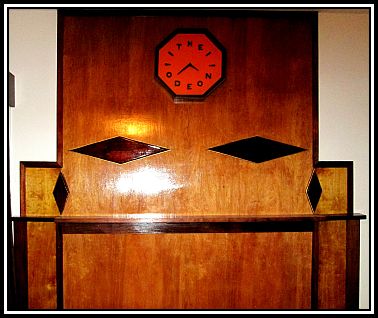
I recently discovered something more of interest about Odeon Cinemas. It seems that Oscar Deutsch’s wife ran a company called Cinema Supplies. The company provided internal fittings for the original Odeon Cinemas. Local companies were formed for each Cinema, thereby minimising the capital outlay for the parent company. One of the conditions was that all fittings were to be purchased from Cinema Supplies and so ensured that the brand image was maintained and, obviously, prevented outside suppliers competing for a share.
-oOo-
J. Arthur Rank began to produce films in early 1930s and soon experienced difficulties in getting them exhibited in cinemas. Once he realised that the cause his difficulties were caused by those that controlled the British Film Industry he decided that he would not only produce films, but also exhibit them in his own cinemas and thereby bypass the impeding forces. With the death of Oscar Deutsch in 1941, J. Arthur Rank acquired the Odeon Cinemas and also took control of both the Gaumont and the Paramount Cinema Chains. By 1942, The Rank Organisation operated a total of 619 cinemas. The Gaumont and Odeon Circuits were operated independently of each other until they were merged in 1960.
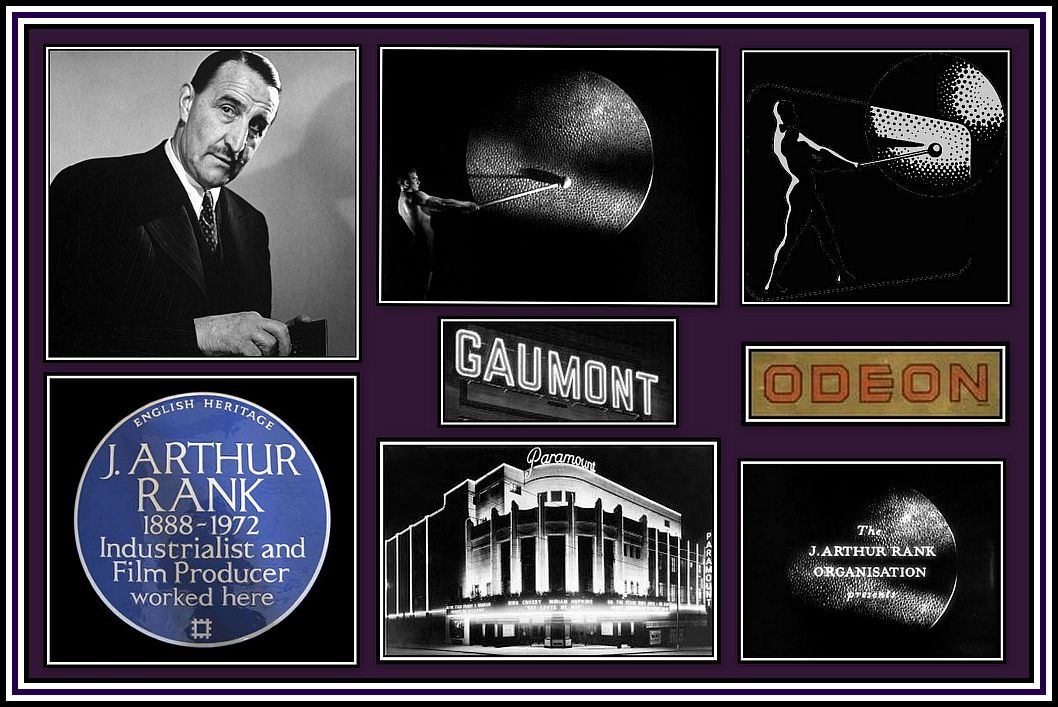 J. Arthur Rank and his acquisitions
J. Arthur Rank and his acquisitions
-oOo-
The three major circuits were thorns in the side of any smaller circuits, as they had arrangements with the British and American film production companies to screen the pick of their films first. The minor circuits spent their time gathering up the crumbs that fell and survived through a combination of ingenuity, seizing on opportunity once presented and luck. The minor circuits either screened films oftentimes rejected by the major circuits or screen popular films once they had been shown in the cinemas of a major circuit. If a minor circuit cinema was lucky enough to be present in towns or cities where not all three major circuits were represented, they were offerd prime material for screening. People like Sol Sheckman with his Essoldo Cinema Circuit and the Bernsteins proved to be matches for the big boys and often singed the beards of bigger companies through their chutzpah.
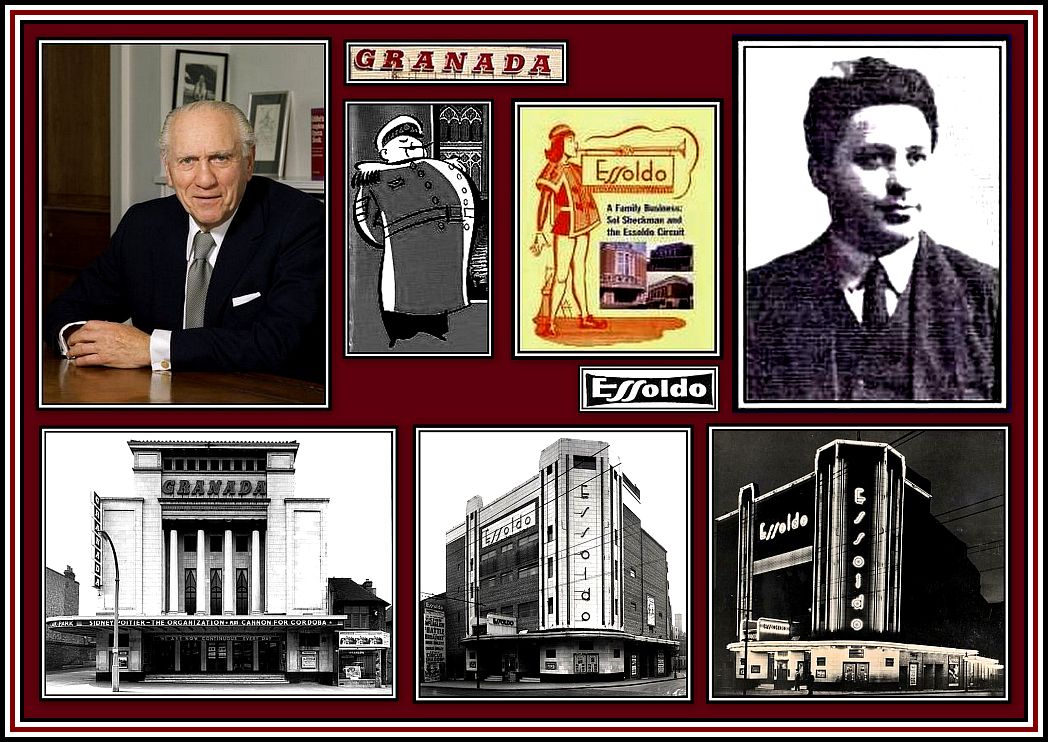 Sergeants & Heralds & Flagship Cinemas-Theatres
Sergeants & Heralds & Flagship Cinemas-Theatres
Sidney Bernstein (left) & Sol Sheckman (right)
—ooOoo—
BUILDING THEIR FIRST THEATRES
-oOo-
In 1929, the Bernsteins bought land in Dover where the first Granada Theatre would be built with the aid of architect Cecil Audrey Massey and Theodore Komisarjevsky, the theatre director-cum-costume designer-cum-theatre interior designer etc. This theatre was soon followed with the building of a Granada at Walthamstow and then Tooting. Although the Granada Dover was quickly sold, it formed the beginning of what was to become a circuit of 56 theatres by 1948. Certainly The Granada Theatre Circuit never became the largest of the British Cinema Circuits, however, in my humble opinion, it did prove to be the most glorious.
—ooOoo—
THE FIRST CIRCUIT
-oOo-
Mr. Bernstein was a showman and obviously enjoyed making announcements that would set people talking. I am sure that this was exactly what happened in March 1933 when Sidney Bernstein announced that he was to start a circuit of twelve theatres in provincial towns where he planned to show film and live theatre.
—ooOoo—
THE GRANADA THEATRE MAIDSTONE
-oOo-
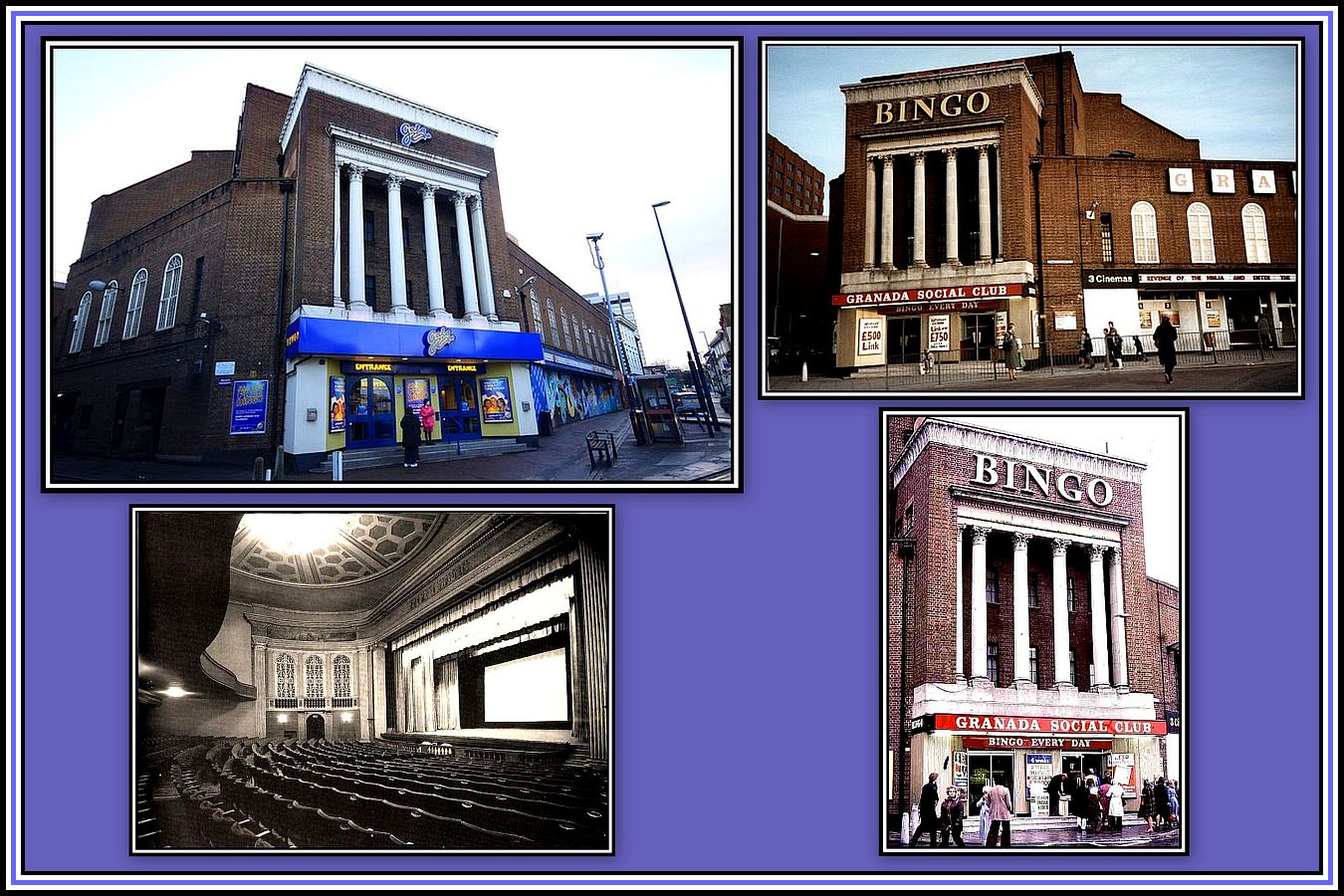 Granada Theatre Maidstone
Granada Theatre Maidstone
Top Left: as a Gala Bingo Club; Top & Bottom Right: as a Granada Social Club
Bottom Left: the auditorium; note the undulating balcony outline
Many of the theatre’s features were used in the template for later Granada Theatres,
some of which had appeared earlier in the interior design of The Phoenix Theatre
-oOo-
The first of the circuit of twelve theatres to be built was the Granada Theatre Maidstone, which opened in January 1934 and is discussed in the section found by:
CLICKING HERE
—ooOoo—
THE GRANADA THEATRE SHREWSBURY
-oOo-
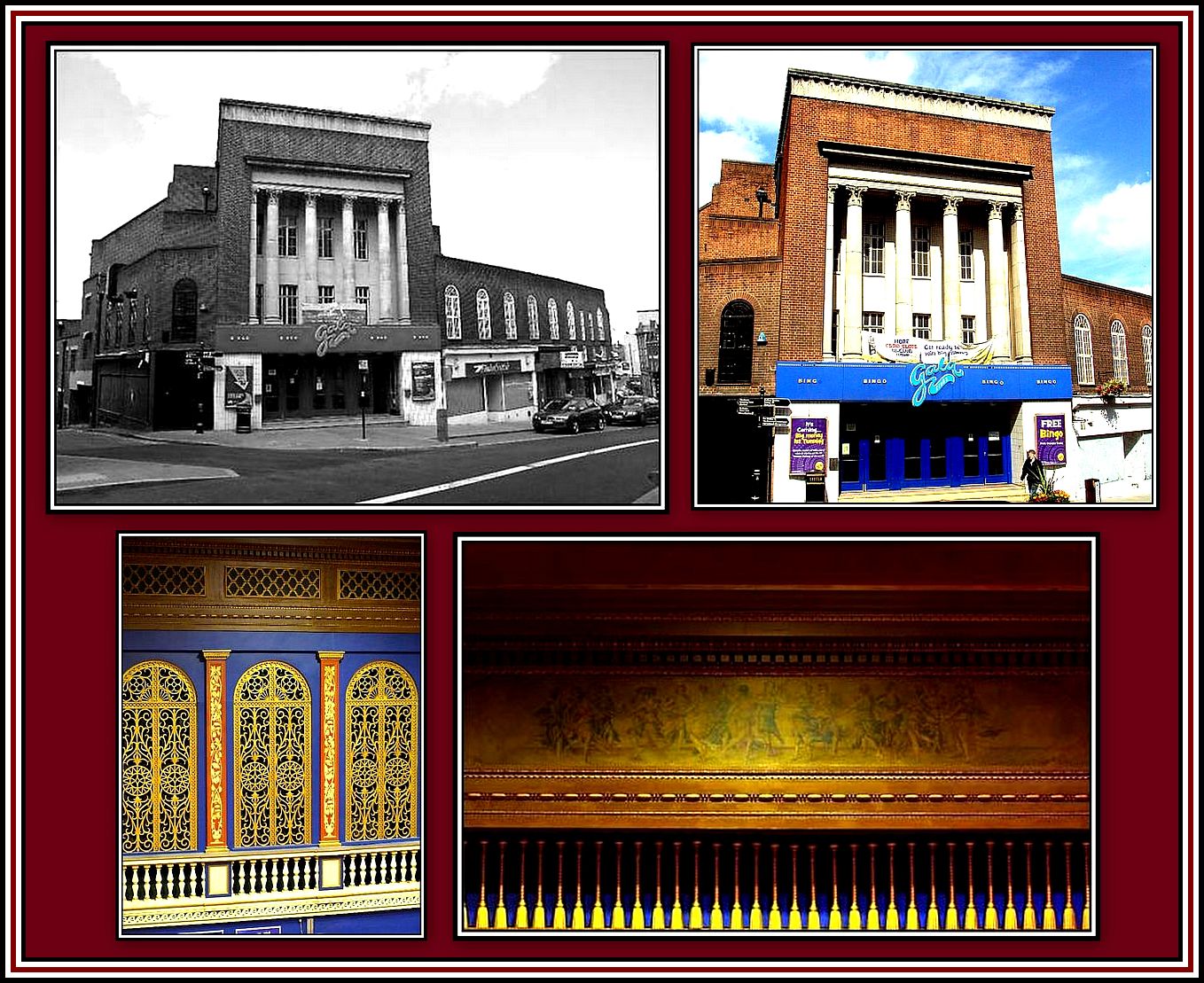 Granada Theatre Shrewsbury
Granada Theatre Shrewsbury
Top: Views of the exterior once it became a Gala Bingo Club
Bottom Left: Auditorium grille work, which was also installed at the Granada Bedford and at number of other theatres; Bottom Right: Frieze work
The Granada Theatre Shrewsbury opened in December 1934 and is discussed in the section found by:
CLICKING HERE
-oOo-
Click here to watch FROM PICTURE PALACE TO MULTIPLEX: CINEMAS IN THE MIDLANDS Included here is a section dealing with the building of the Granada Theatre Shrewsbury
-oOo-
For those readers wishing to see what the interior of the Granada Theatre Shrewsbury looks like today as a Gala Bingo Social Club, please follow the link below. These photographs were taken by Mr. Paul Bland and show what a remarkably good state the building is in also show that many of the original features of the Theatre are still present:
CLICK HERE TO SEE THE PHOTOGRAPHS
(The reader needs to scroll down towards the end of the album to see them.)
—ooOoo—
THE GRANADA THEATRE BEDFORD
-oOo-
 Granada Theatre Bedford
Granada Theatre Bedford
Top Left: Exterior soon after opening; Top Right: after the auditorium had been twinned
Bottom Left: Foyer with a Miss Candy counter on the right wall; Middle: stage show posters
Bottom Right: Plaque to commemorate the theatre following its demolition in December 1990
The architects for the Granada Theatre Bedford were William T. Benslyn and James Morrison with Theodore Komisarjevsky being responsible for the interior design. The theatre opened in December 1934 and is discussed in the section found by:
CLICKING HERE
—ooOoo—
STARTING ANOTHER CIRCUIT
-oOo-
With 1936 came another announcement from Granada stating that it was to build eight new theatres, which later in the year was increased to sixteen. Despite the announcements, only nine theatres of this group were actually built and would form what was to be a new circuit. Unfortunately I can find no reason for Granada calling these nine theatres a new circuit rather than simply include them with the earlier ones.
—ooOoo—
THE GRANADA THEATRE WANDSWORTH
-oOo-
The Granada Theatre Wandsworth was the first to be built in what was considered to be the beginning of a new circuit. The Theatre was designed by E.D. Lyons, L. Israel and C.H. Elsom. opened in October 1936.
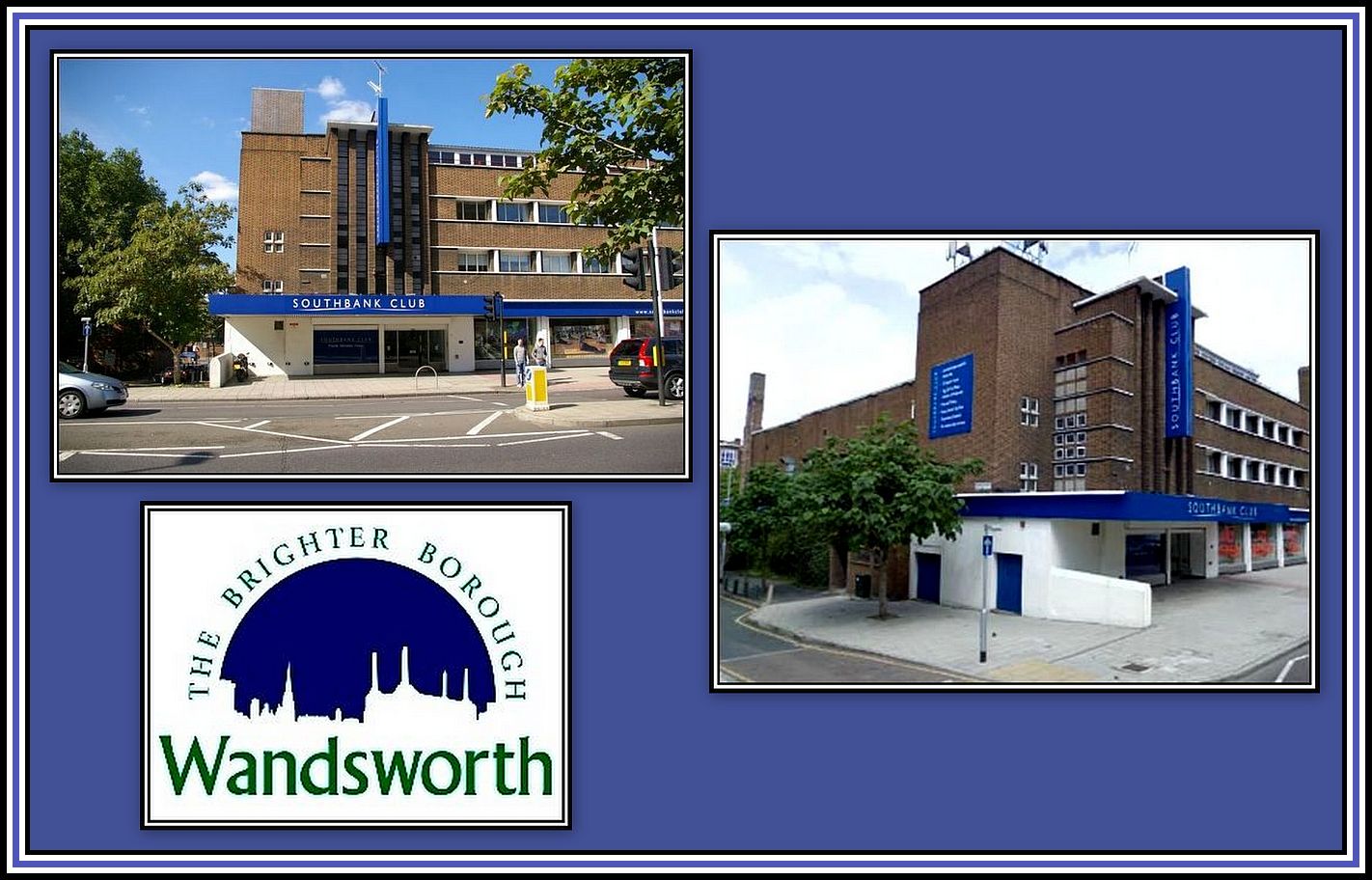
-oOo-
The Granada Theatre Wandsworth is discussed in the section found by:
CLICKING HERE
—ooOoo—
THE CENTURY THEATRE CHEAM
-oOo-
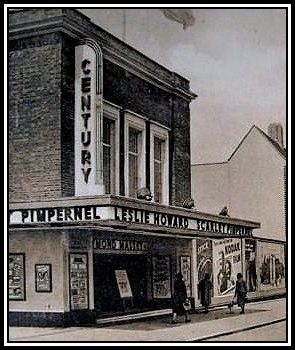 This is the only picture I could find of the Century Theatre Cheam
This is the only picture I could find of the Century Theatre Cheam
(reproduced from Cinema Treasures)
The Century Theatre Cheam opened in March 1937 and was apparently an experiment to see if this smaller type of theatre would be viable or not.
The Theatre is discussed in the section found by:
CLICKING HERE
—ooOoo—
THE GRANADA THEATRE WOOLWICH
-oOo-
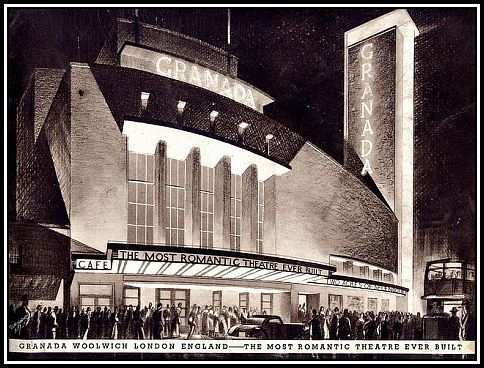
The Granada Theatre Woolwich opened in April 1937 and is discussed in Part Eleven of this series.
—ooOoo—
THE GRANADA THEATRE NORTH CHEAM
-oOo-
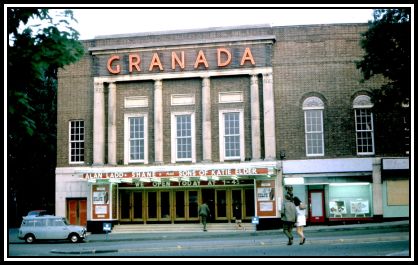 The Granada Theatre North Cheam
The Granada Theatre North Cheam
This photograph was provided by Mr. Ian McIver.
The Granada Theatre North Cheam opened in September 1937 and is discussed in the section found by:
CLICKING HERE
—ooOoo—
THE GRANADA THEATRE GREENWICH
-oOo-
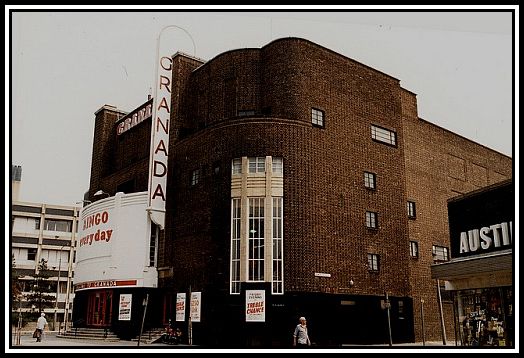 The former Granada Theatre Greenwich as a Granada Social Club
The former Granada Theatre Greenwich as a Granada Social Club
The interior design of the Granada Theatre Greenwich differed from other Granada Theatres of this time in that it did not follow the template introduced at Maidstone, but resembled more the Empire-Granada Theatre Edmonton.
The theatre was opened in September 1937 by Gracie Fields and was equipped with a Wurlitzer Organ and full stage facilities with some 1,900 seats.
-oOo-
The Theatre is discussed in the section found by:
CLICKING HERE
—ooOoo—
THE GRANADA THEATRE HARROW
-oOo-
 The former Granada Theatre as a Gold’s Health & Fitness Club in 2014
The former Granada Theatre as a Gold’s Health & Fitness Club in 2014
The Granada Theatre Harrow opened in 1937 with Jessie Matthews and Sonnie Hale present and is discussed in the section found by:
CLICKING HERE
—ooOoo—
THE GRANADA THEATRE CLAPHAM JUNCTION
-oOo-
The Granada Theatre Clapham Junction opened in November 1937 in the presence of the Duchess of Kent and Victor Mag and is discussed in the section found by:
CLICKING HERE
-oOo-
In November 2014, I was fortunate enough to be given a tour of the Granada Theatre Clapham Junction, now renamed Transformation House, by Mr. Mark Featherstone. I was given free-range to photograph the building and those that I took may be seen by:
CLICKING HERE
—ooOoo—
THE GRANADA THEATRE GREENFORD
-oOo-
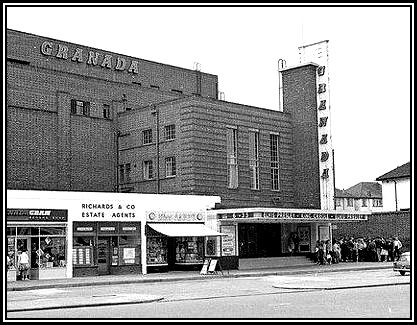 The Granada Theatre Greenford in 1958
The Granada Theatre Greenford in 1958
The Granada Theatre Greenford opened in November 1937 by Gracie Fields and was advertised as The Wonder Theatre of 1938.
The Theatre is discussed in the section found by:
CLICKING HERE
—ooOoo—
THE GRANADA THEATRE WELLING
-oOo-
The Granada Theatre Welling opened in February 1938. Although George Coles was the architect, and was renown for his Art Deco designs, the exterior of the Theatre was remarkably plain and of brick and lacking decoration except for five long windows.
The Theatre is discussed in the section found by:
CLICKING HERE
—ooOoo—
THE GRANADA THEATRE SLOUGH
-oOo-
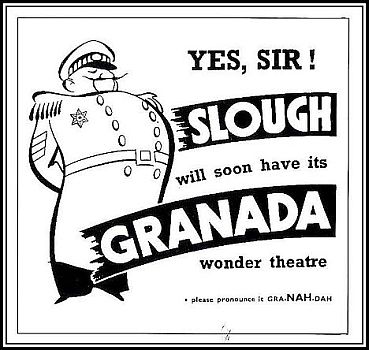
The Granada Theatre Slough opened in March 1938 and is discussed in Part Twelve of this series.
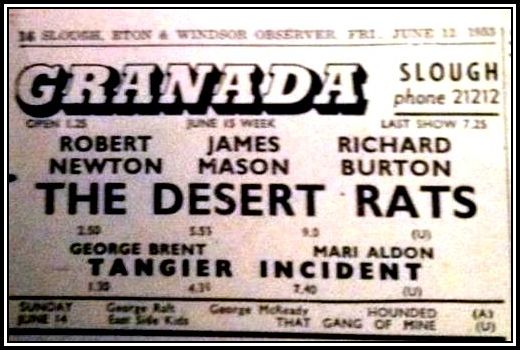 An Advertisement appeared in the Slough & Eton Express in 1953
An Advertisement appeared in the Slough & Eton Express in 1953
This advertisement appears with permission of Paul Bland
-oOo-
The Theatre is discussed in the section found by:
CLICKING HERE
—ooOoo—
THE GRANADA THEATRE KINGSTON
-oOo- The Former Granada Theatre Kingston in November 2014, as a Pryzm Nightclub
The Former Granada Theatre Kingston in November 2014, as a Pryzm Nightclub
Although The Granada Theatre Kingston was the last Theatre to open as a purpose-built-Granada, it was in fact a take over, as the building was originally to form part of a group of State Cinemas to join those of Kilburn and Holloway. Theodore Komisarjevsky was responsible for the interior decor with Cecil Audrey Massey as consulting architect.
The Theatre is discussed in the section found by:
CLICKING HERE
——-oooOOOooo——
Although no additional custom-built Theaters were constructed by The Bernsteins, they did increase the size of their Circuit by a number of take-overs, as will be discussed in the next section:
TO READ ABOUT TURNING EMPIRES AND OTHER KINEMAS INTO GRA-NAH-DAHS, PLEASE
CLICK HERE
——oooOOOooo——
ACKNOWLEDGMENTS
Some of the history of the theatres appearing here came from The Granada Theatres by Allen Eyles. I am grateful to Mr. Eyles for this great book.
I would like to thank Simon Gledhill for his help by answering the many questions asked.
I would like to thank The Organ Society of Australia (Queensland) for their help and to Mr. Ian McIver.
I would like to thank Andrew Gilbert for providing information on the Plaza-Granada Sutton.
I would like to thank Len Rawle, dusashenka, Peter Towell, Gary Painter & Gordon Barr of Scottish Cinemas, David Cresswell, Kevin Lane, Graham Atkinson, Andrew Woodyatt and Joshua Abbott for allowing their photographs to be reproduced here.
I would also like to thank Mr. Adeel Anwar, Club Manager of Gold’s Gym, Harrow for his kindness in showing me around the former Granada Theatre Harrow.
I would like to thank Clive Polden of the Cinema Treasures Association for allowing their photographs to appear here.
I would very much like to thank Robert Plummer for allowing his photographs to be reproduced here.
I am extremely grateful to the following who were kind enough to show me around former Granada Theatres: Mark Featherstone (Granada Theatre Clapham Junction), the Minister of the Destiny Christian Centre, Acton (Granada Theatre Acton), the owner of the former Granada Theatre East Ham (which is soon to reopen as a Function Centre) and to the owner of the South Bank Fitness Centre (Granada Theatre Wandsworth).
Special thanks are given to the Assistant Manager of the Tesco Supermarket Greenford for help and consideration.
I am especially grateful to Paul Bland for sending some copies of photographs that appear here and for offering helpful comments and very useful facts.
Finally, I would like to thank Kenneth J. Clemetson for contacting the Collège Claparède in Geneva and finding out that the Wurlitzer Organ of the Granada Theatre Clapham Junction is still in playing order.
——oooOOOooo——
Click here to go to PART ELEVEN: THE GRANADA THEATRE WOOLWICH
——oooOOOooo——
Click here to return to PART NINE: THE GRANADA THEATRE TOOTING
——oooOOOooo——
Click here to return to THE GRANADA THEATRE CIRCUIT Home Page
——oooOOOooo——
Click here to return to the TABLE OF CONTENTS
——oooOOOooo——

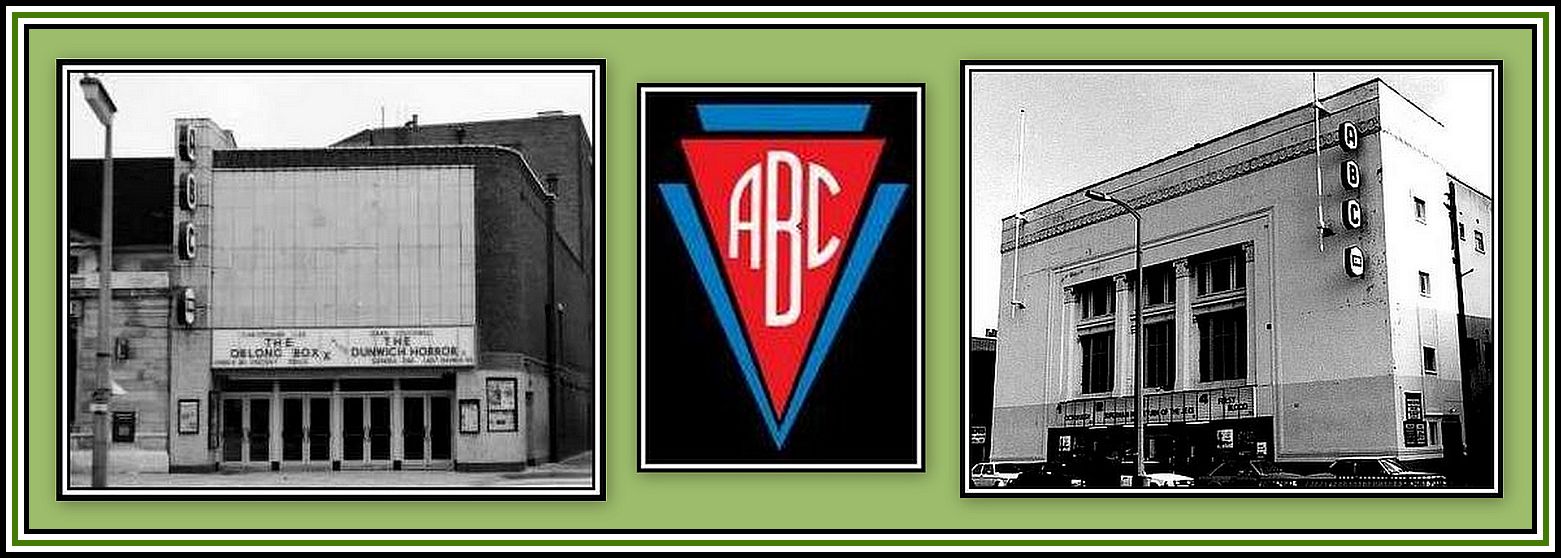
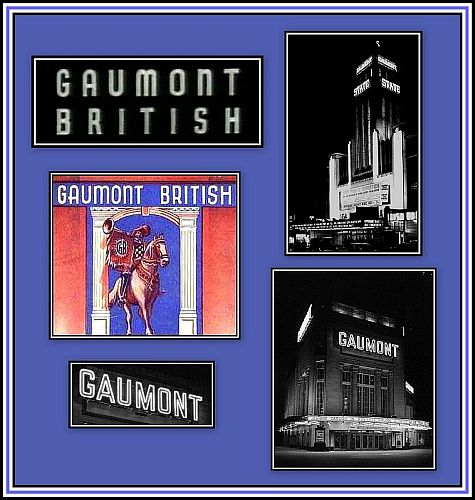
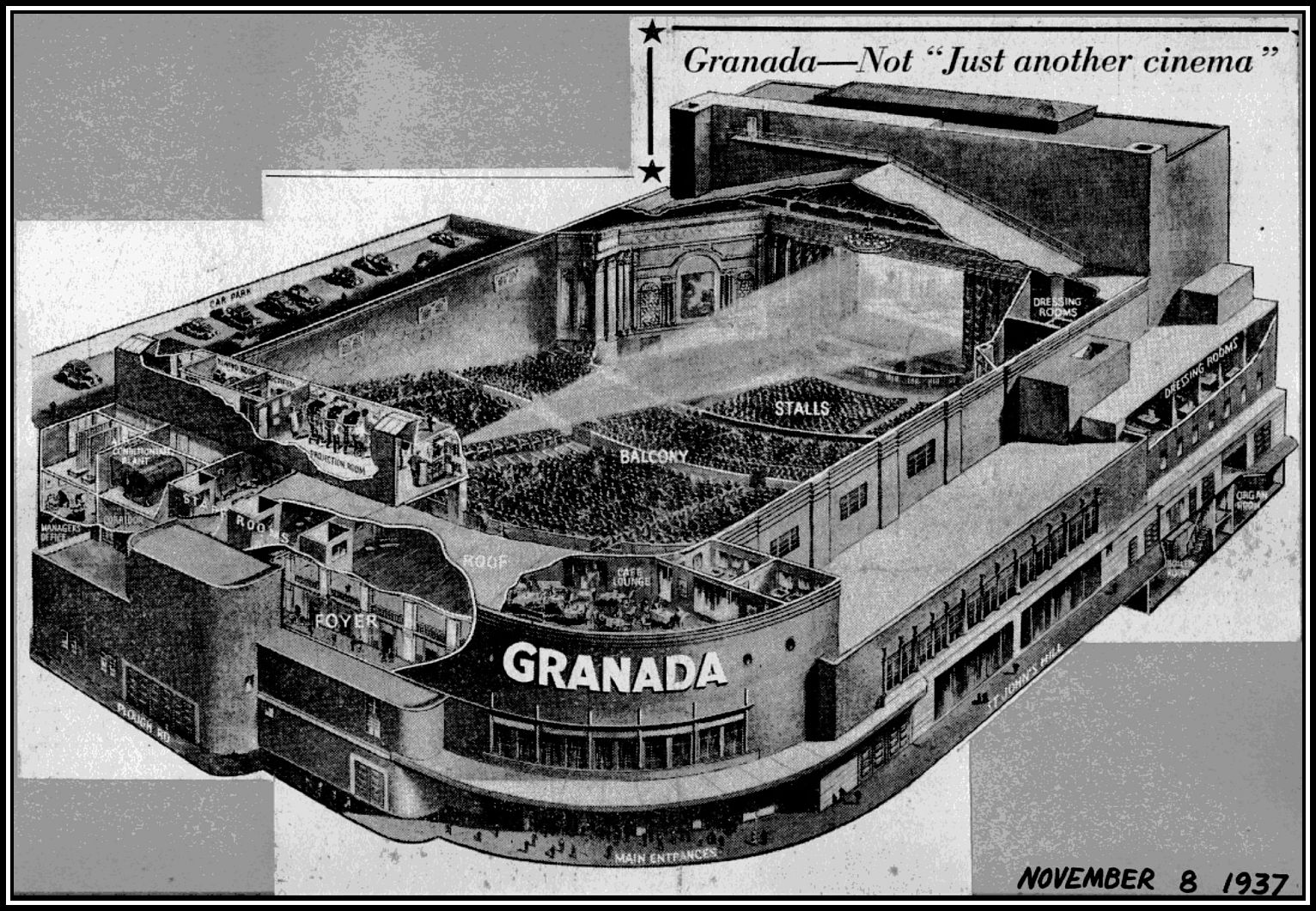
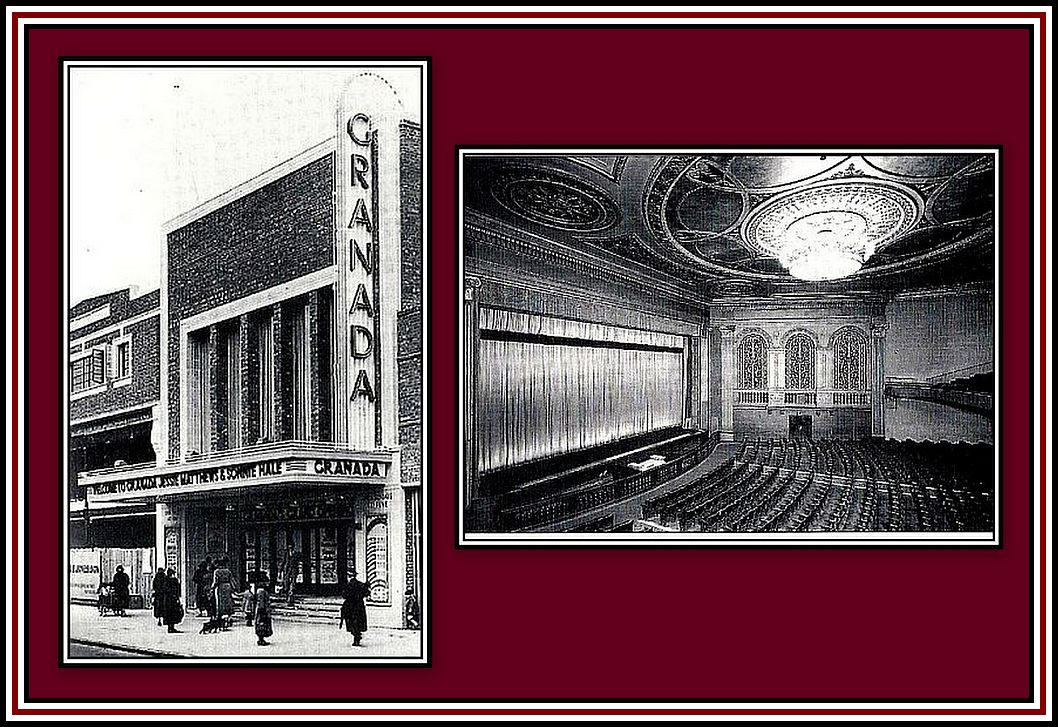
I have a great fondness of the Granada chain – particularly the Clapham Junction theatre. As a child I was a regular member of the Granadier club, in my youth I took many a girlfriend to that cinema. Later, as a young married man (by now living away from my childhood home of Battersea) I still paid occasional visits when Sunday morning organ concerts were held there in the 1970’s (that is until the organ was taken out and shipped to Switzerand).
Just a comment regarding the Maidstone Granada. When I was working at the Middlesex Hospital in the 1970’s, we had a young Australian PhD student working with us. One day we were chatting about his home town of Brisbane. I mentioned the Maidstone Christie, which would have been newly installed at the Kelvin Grove High School (as it was then known) then.To my surprise he told me that this was his old school, and that he remembered the anticipation of awaiting the installation of the organ. Incidentally, on Christmas Eve Maidstone town centre flooded again after several days of torrential rain.
I saw a couple of films in the Wandsworth Road Granada in my youth. This was quite different from any other purpose built cinemas in the chain. The exterior was very modern for a 1930’s building – more in keeping with a 1950’s block of municipal flats. The interior was very bland and uninspiring. Being situated in a highly industrial part of Battersea – known by locals as “bomb alley” – it is not surprising that it suffered extensive damage during the Blitz phase of WW2. Neighbouring infrastructure included railway lines running into two major termini, Waterloo and Victoria, numerous goods yards and loco sheds, a large gas works, a munitions factory plus the iconic Battersea Power Station to act as a beacon for the German raiders.
Another point of interest regarding the Wurlitzer organ. This was removed by Les Rawle and installed in his home at Northwood. I believe this was the first of many cinema to home transplants, including the Empire, Leicester Square, organ now adorning the lounge in his son, Les, Chorlywood home.
Peter:
Many thanks for your comments – they will be much appreciated by readers and are much appreciated by me.
Charles
The Granada Shrewsbury was my home town Theatre/Cinema and the place responsible for giving me so many memories. Your web page is excellent and has resulted in inspiring me to create an album of my 30 plus programmes that had previously been spread around in various files. I am a collector of theatre memorabilia.
Much of information about the Granada was new to me and the interior pictures have brought the building to life again, as in my mind I have taken the familiar walk from the front entrance down stairs through the lobby area into the stalls or from that front foyer up a couple of steps, along a balcony area to the circle. I never thought I would be able to relive it all again (albeit only in my mind). I did appear on stage as a member of a skiffle group in the late 1950s.
Trevor: Many thanks for your comment. I look forward to hearing more from you. I am sure that other readers would be very interested in hearing more of your memories of the Granada Shrewsbury and of your skiffle days. I know that I would. Charles
Wow – what a fabulous resource. Thanks so much for putting this wonderful achieve together for fans and enthusiasts of these magnificent old venues.
Recently I received a letter from a reader where he spoke about the Skiffle Group that he and his friends formed in 1957. They entered an Amateur Contest at the Granada Shrewsbury and won. This took them to Birmingham and a place on a television national talent show. Although they did not win, they all had a great time. Apparently, the ex-members of the group enjoyed a reunion not long ago and enjoyed remembering ‘old times’.
I thought that this letter would be better suited to being in the piece itself, in the section dealing with the Granada Theatre Shrewsbury.
I hope you enjoy this letter as much as I have.
Hello Charles. I have just spent a while reading through the Granada pages again. It is great to have so much about the circuit here in one place. It is also rather sad to see what has been lost; some breath-taking interiors either demolished or converted beyond recognition. Equally, it is good to be reminded of what remains so there is a chance to catch sight of what was a small, but significant circuit. I only ever saw films in one Granada, that in Leytonstone in, I think 1972. Taking leave of my then girlfriend, I strolled down to the front where, to my delight, I saw the console of the Compton, only partly covered by its dust sheet. That made the visit really worthwhile. One of the things I enjoy about your pages is the way the show the other uses to which the theatres were put, wrestling, stage shows and indicate how much they were a part of the social fabric, catering for a variety of tastes beyond the simply celluloid. Most enjoyable; thank you.